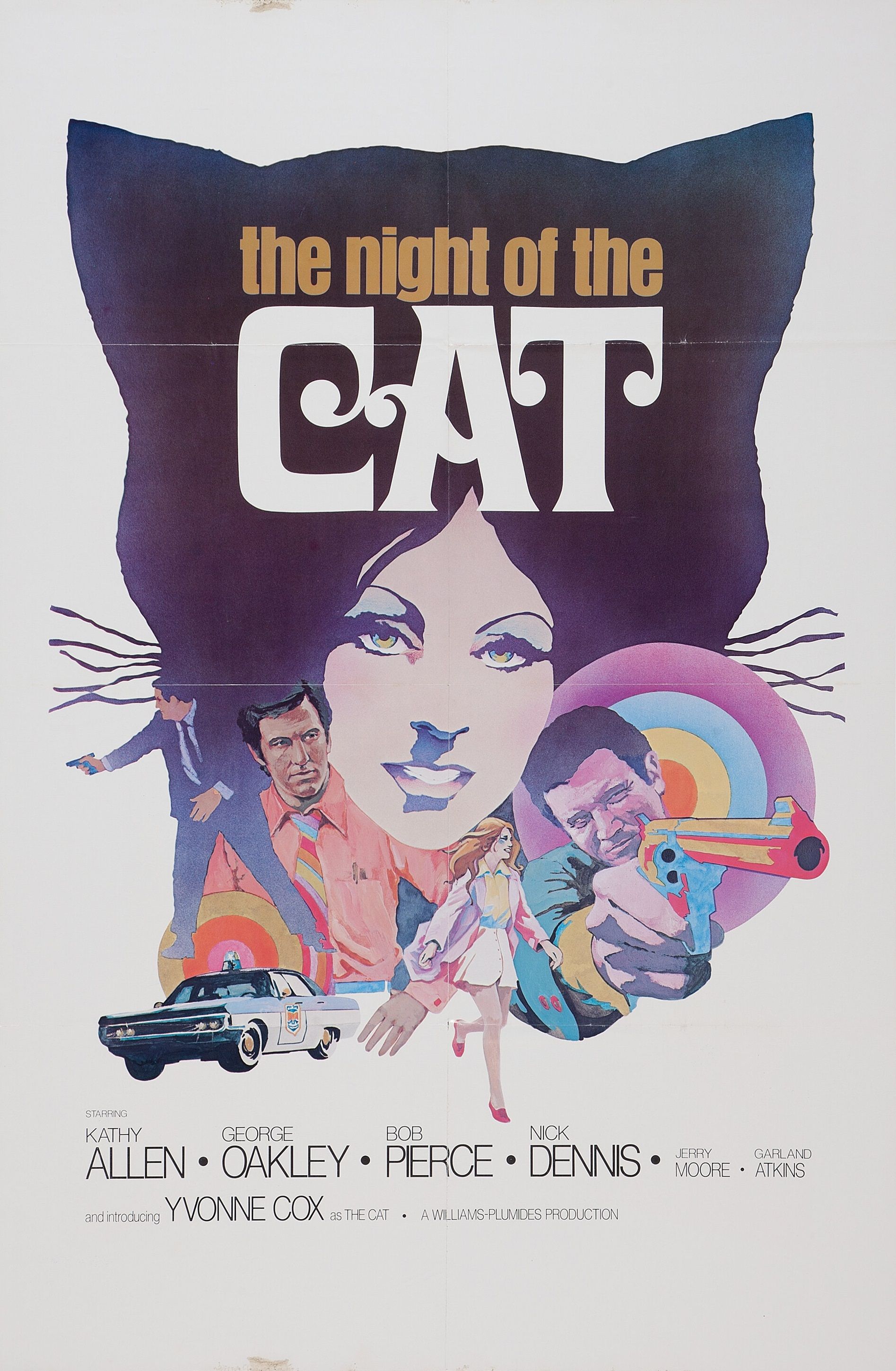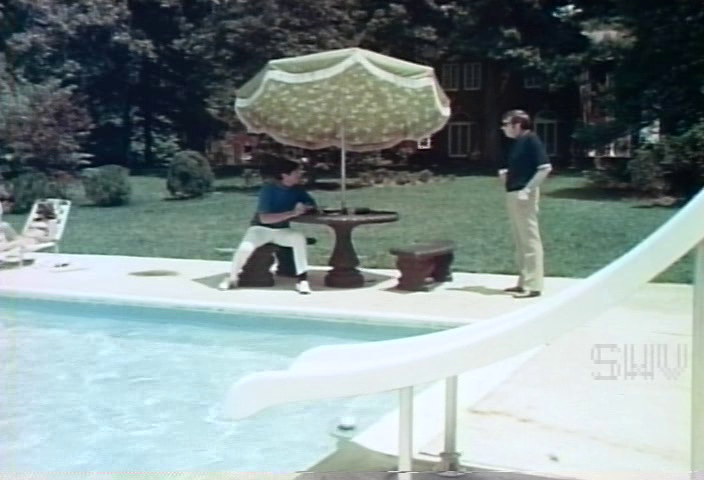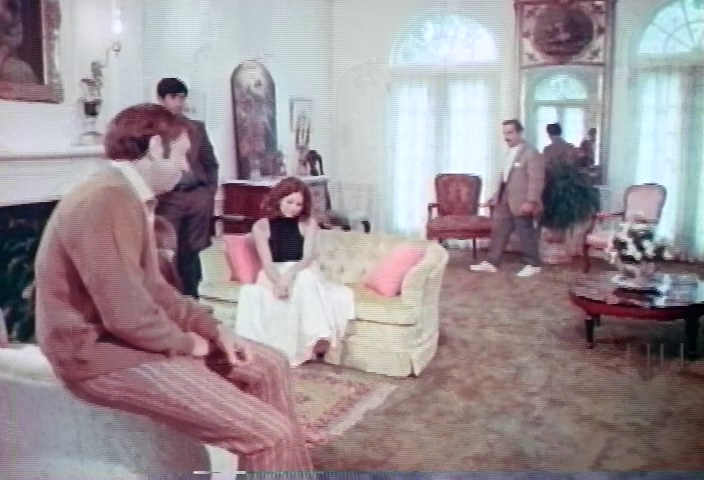Night Of The Cat: The Forgotten Southern Sexploitation Disasterpiece

By Michael G. Plumides, Jr.
Night of the Cat was filmed entirely in Charlotte, North Carolina, and its environs in 1972 and released in 1973 to very little fanfare. The production was marred by controversy and rife with underhanded dealings, although the film originally began with a big buzz in the papers. Some press was positive, and some wasn’t. The movie was produced by my father - Michael Plumides, an attorney and nightclub owner, although the intervening illegality began months before he was involved with the film.
The driving force behind the production was a man named Norman Williams, a weaselly conman with his underdeveloped physique, horn-rimmed glasses, and mousy receding hairline. Bearing a resemblance to Woody Allen, Williams was arguably a criminal-minded filmmaker who would do anything to make his vision come to life. I’m sure some of you reading this may have an inkling regarding the determination and sheer will it takes to complete a film. Norman Williams not only committed numerous acts of criminality, but he also went to jail for his art.
My father owned a nightclub in Charlotte that was regarded with some infamy, called the C'est Bon, located in the heart of Plaza-Midwood on Central Avenue. Several marquee entertainers had played at the venue, including acts such as Bo Diddley and The Drifters. The featured entertainer, however, was none other than Morgana, who was later described as "The Kissing Bandit" throughout the '70s and '80s. The exotic dancer had received some notoriety, appearing on late night talk shows and was a feature in Playboy. Arguably, my father discovered Morgana, and prompted some of her more risqué promotions. An interesting factoid is, Morgana took my brother, George, and I to the movies on several occasions. She accompanied us to matinee screenings of a Planet of the Apes double-feature but also Butch Cassidy and the Sundance Kid. Morgana loved to go to the movies.
Anyway, my father's nightclub was burned to the ground in 1971. The two arsonists who committed the crime were arrested and convicted. Here’s the thing. I was recently contacted by a man with some information my father was never privy to. He insisted a rival club owner, recently deceased, bragged he had paid the convicted arsonists to set the club on fire. The rival club owner also threatened their lives if they snitched, as the man was said to be, “mobbed up”.
The C’est Bon Club, due to its exotic nature, had generated some legal woes and was on the verge of being closed by the ABC board. I remember visiting the club as a child, and my socks sticking to the floor due to spilt beer and Coca-Cola. The night the C’est Bon was ablaze, my dad lay in the foyer of the brick mansion he had recently purchased. I sat on the steps with my mother in her nightgown. Dad had recently had the entire house carpeted hunter green. My mother said to him as he laid there, sprawled out under the crystal chandelier, “Mike, the C’est Bon is on fire.” He answered in a low gurgle, “Let it burn.” After years of speculation that my father had burned the club down himself, I felt the information regarding the rival’s plot vindicated him of any wrongdoing.

Dad continued to fight “Obscenity Laws” all the way to the North Carolina Supreme Court even after the arson had occurred. And wouldn't you know it, he won his case regarding alcohol sales and topless dancing, the precursor to Miller v. California which set the standard for defining “Obscenity”. Dad won his Supreme Court case against the alcoholic beverage commission in 1971. Coming out swinging, he went into business with a fellow by the name of Dallas Sowell, who owned a bar in the Oakhurst area called the Midnight Sun. That location would become the second incarnation of the C'est Bon Club where one scene was filmed. So, dad would practice law during the day and was a club owner by night and would fit in eighteen holes of golf when he could.
Around the same time, Norman Williams was producing a movie locally, entitled, Night of the Cat. It was big news exploited weekly by a columnist for The Charlotte Observer named Kays Gary. Oddly, Norman Williams had landed himself in jail for fraud by an early investor and supporting actor in the film, Garland Atkins. Garland’s family owned four newspapers in the area. Atkins had filed an arrest warrant to put Williams in the pokey for acquiring $15,000 from Atkins under false pretenses.
When Williams approached Atkins, he was skeptical, so he asked Kays Gary to advise whether Williams had any of his own money. Gary told him, “Norman’s got some big investors from Chicago.” Norman Williams had no such investors. Once Williams had secured Atkins’ money, he threw a lavish party on the top of the parking deck of The Hilton and rented a helicopter to transport the stars of the film for the press. The helicopter blew the food everywhere. Atkins found out he was paying for it all.
According to Atkins, “The production started at the hotel. Williams wanted me to do a nude scene, but I refused, so I got to keep my bottoms on. There was this naked girl there and I said, ‘Do I know you?’ She said, ‘I work for you at the newspaper.’” Atkins was shocked. He went on to say, “In one of the first scenes of the movie we shot, actress Yvonne Cox, who played the cat woman kicked a gun I was holding, breaking my hand.” Another of Atkins’ grievances was, apparently, “there was no script. Norman Williams was writing the script every night, for the next day.”
The sordid nature of the film Williams was making was only surpassed by the sordid tales of the film’s production. In addition, Williams, the writer/producer/cinematographer was also arrested for passing $13,000 in bad checks from Southern National Bank to make the film. Williams even used Belmont, North Carolina police vehicles in a chase scene, wrecking some of them, and paying them a fraudulent check. Williams was sentenced to 18 months in prison that May, although the sentence was suspended until July of 1972, giving the filmmaker the opportunity to pay back the money he had defrauded. Never one to pass up an opportunity, in stepped Michael G. Plumides, Esquire, fresh off his Supreme Court victory.
Dad represented Norman Williams, and to make his legal difficulties go away, Attorney Plumides mortgaged “The House that Morgana Built” to put his name on
Night of the Cat. Dad had originally paid cash for his home and credited Morgana for creating the revenue to do so. Atkins was repaid and promised 5% of the gross. In an article in the Gaston Gazette, dated December 3, 1972, Plumides was quoted to say, “This picture is going to make Garland Atkins a star.”


Dad had a lot of friends in show business. There was Sidney Blackmer from Rosemary’s Baby and John Bromfield from Revenge of the Creature from the Black Lagoon. But Dad brought in his friend, Nick Dennis, a fellow Greek and character actor who had supporting roles in films like A Streetcar Named Desire and Spartacus but had been working in television in his later years, more notably a recurring role on Ben Casey. Dad also brought in – you guessed it, Morgana, to make an appearance.
I was seven years old during the film’s production. Some scenes from the movie were shot at the paleaceous Georgian Colonial home I grew up in: Both interiors and exteriors in the house and by the swimming pool, which I witnessed. In the basement, Williams shot an adult themed scene I was not allowed to watch. My two-year-old brother Damon would make his film debut, in the arms of monstrous wrestler, Big Dave Ox. My mother would also make her film debut as “Joyce” however, with no speaking lines. Nick Dennis did sling his cocktail glass at her spontaneously, which she caught, not spilling a drop, as Dennis delivered his monologue.
Only a day or two I remember Jim Cinque being on set, with his shoe-polish hair, Ray Bans and Penguin tennis shirt, although he would take top billing as director. There was no doubt Williams called the shots. Williams probably tacked Cinque’s name on there because of his own bad publicity. I feel that Dad elevated the production, adding Nick Dennis and his house. But the acting and fight scenes that took place there were still atrocious. Nick ruled the set while he was there, playing the mob boss. He improvised most of his dialogue. During production, my father was already trying to recoup some of his losses after mortgaging the house for $100,000. He pulled Atkins aside and made him a cocktail, asking him to put another $15,000 dollars in. Atkins declined.
The production wrapped in August of 1972. During post-production, there was gorgeous poster art created, and the musical score was provided by Arthur Smith Studios. The film was originally given an "X" rating but later edited to receive an "R" by the Motion Picture Association of America. Worth Keeter, a Director for Earl Owensby and friend, said, “That was a tactic the MPAA would use to appease the big studios. In those days, any independent film with nudity would get an X rating.” The film opened at The Astor Theater in Charlotte, now The Neighborhood Theater, to horrible reviews. At the time, The Astor was consigned primarily to porno movies and was of some ill-repute, so that may have contributed to the film’s failure, locally. The film was also poorly distributed by a company in Atlanta, called Dominion.
Although Night of the Cat was a consummate failure, resulting in a bout of depression and alcoholism, my father soldiered on, however, the aftermath of the film’s failure resulted in him having a stroke in 1975 and subsequent separation from his wife. He still somehow got Diana Goodman, Ms. Georgia and Elvis Presley’s girlfriend to come and stay with him for several weeks behind the promise of producing his next film.
Dad’s 35mm copy of the film was given to a business on Pecan Avenue that my dad frequented called, The Photo Lab, one of the first in town to rent movies on VHS. My dad wanted
Night of the Cat transferred to video tape. Upon completion, Dad argued over the rather pricey bill and refused to pay it. The Photo Lab kept the only copy he had.


After years of declining health, my dad passed away on August 12, 1995. I was administrator of my father’s estate. I was charged with itemizing his personal and real property for the Mecklenburg County Special Proceedings office, and I knew Night of the Cat would pop up on a new search engine called “Google” at some point, however, my yearly searches for the forgotten celluloid catastrophe produced nothing.
Fast forward to 1999. Mike Vraney at Something Weird Video found Night of the Cat in a cache of films and had the film transferred and released it on DVD-R. Mike was one of the founders of Alternative Tentacles records, who released such legendary punk records by Bad Brains, Dead Kennedys and Jody Foster’s Army. I found the information on Google and contacted Mike. He and I hit it off immediately, as I was a second-generation club owner and heavy into the punk scene in the late 80’s and early 90’s.
Just an aside. My club, 4808, was shut down by officials in Charlotte after the notorious Gwar bust of September 1990 for an “obscene” performance. And wouldn’t you know it? The case law regarding “obscenity” my father fought all the way to the Supreme Court and prevailed, had been overturned by legislators in 1987. A plea bargain required me to complete 170 hours of community service in 3 months, which I did. So, Mike Vraney and I had lots to talk about considering his interest in punk music and raunchy video content.
Vraney provided ten copies of Night of the Cat for me, which I distributed to some kitschy independent video stores throughout the southeast in the interest of introducing the forgotten film to hipster circles. Vraney had the only known existing 35mm print of the film that I could find. After Mike's death in 2014, his wife, Lisa Petrucci-Vraney took over Something Weird Video so not to let the business languish. I recently contacted Lisa and she provided me with new copies of the original print.
Last year, Something Weird Video’s 35mm print was acquired by Nicolas Winding Refn, more notably, the director of such films as Drive and Neon Demon, for his NWR film preservation archive. However, Refn declined to remaster the film. Lisa Petrucci wrote, “Unfortunately, the 35mm film print wasn't in good enough condition to merit having it restored or released on blu-ray. The Something Weird Video version is the only available source. The film has now been dedicated to the Academy of Motion Picture Arts and Sciences Archives.”
"Regional Americana at its weirdest, shot in Charlotte, North Carolina. A celluloid catastrophe about a woman who becomes an avenging 'cat woman' and takes on the mob. With bare titties, godawful acting, hilariously lame 'action', and joyously unconvincing fight scenes, it's a breath-taking wonder from beginning to end. The film probably never played outside of North Carolina, until Something Weird handed it to an unsuspecting world." - Cultpix.com
The film stars Yvonne Cox, Nick Dennis, Garland Atkins, Big Dave Ox, Kathy Allen, George Oakley, Bob Pierce, and features famed exotic entertainer, Morgana. Tickets are available for $8 (link below). The film runs around 1 hour and 20 minutes.
Night of the Cat was arguably Charlotte's first independent film ever shot locally, and the first and only sexploitation/grindhouse film ever made in the Carolinas. One reviewer on IMDb suggested the film, “makes Plan 9 From Outer Space look like Citizen Kane.” The legacy of Night of the Cat has left its mark in the annals of local filmmaking history and can only be described as a Southern Sexploitation Disasterpiece.
The 50th Anniversary screening of THE NIGHT OF THE CAT will be held at the Independent Picture House on Thursday, December 21st at 7:30 PM in Charlotte, North Carolina. The Independent Picture House is located at 4237 Raleigh St, Charlotte, NC 28213. Go to this link for tickets.
Michael G. Plumides Jr. JD is a writer, author and filmmaker. He wrote the lauded indie book, Kill the Music, in 2009 and is currently editing his first work of fiction entitled, Nocturnity, soon to be released hand-in-hand with the comic/graphic novel in 2024. Michael was also Executive Producer of Clive Barker’s Nightbreed: Director’s Cut, a 2015 Saturn Award winner.


